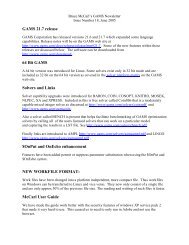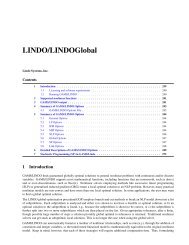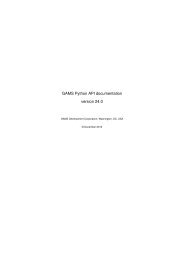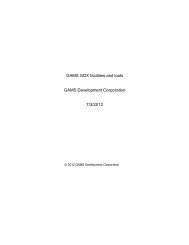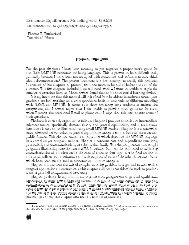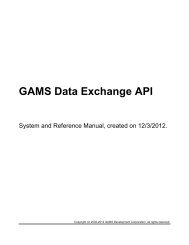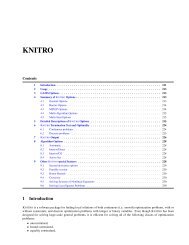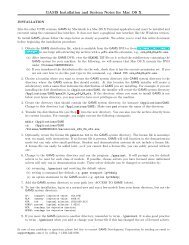XLS2GMS - Gams
XLS2GMS - Gams
XLS2GMS - Gams
You also want an ePaper? Increase the reach of your titles
YUMPU automatically turns print PDFs into web optimized ePapers that Google loves.
1 Contents<br />
Contents<br />
<strong>XLS2GMS</strong>, Version 2.4, May 2004<br />
Erwin Kalvelagen, GAMS Development Corp<br />
Overview<br />
Requirements<br />
Converting spreadsheet data to GAMS data<br />
Importing sets<br />
Importing sets and tables<br />
Importing multidimensional parameters<br />
Multiple-area ranges and post-processing<br />
Interactive use<br />
Options<br />
Batch use<br />
Command line arguments<br />
Command files<br />
$Call command<br />
Note: the bitmaps are best viewed with Large Fonts display settings.<br />
2 Overview<br />
Overview<br />
© 2007 GAMS Development Corporation<br />
Contents 1<br />
<strong>XLS2GMS</strong> is a tool to convert spreadsheet data from a Microsoft Excel spreadsheet into GAMS<br />
readable format. The source is a MS Excel spreadsheet file (*.XLS) and the target is a GAMS Include<br />
File.<br />
When running the executable <strong>XLS2GMS</strong>.EXE without command line parameters the tool will run<br />
interactively with a built-in GUI interface. Alternatively <strong>XLS2GMS</strong> can be run in batch mode which is<br />
useful when calling it directly from a GAMS model using the $call command.<br />
The philosophy of the tool is to consider the content of a spreadsheet as Text. This text can contain<br />
GAMS statements, or parts of GAMS statements (e.g. the data part of a table statement). The text is<br />
exported to a GAMS include file where some spacing is introduced to maintain cell boundaries. This<br />
allows tables to be exported directly to GAMS include files.<br />
<strong>XLS2GMS</strong> is written in Delphi (Pascal). The source is available upon request.<br />
3 Requirements<br />
Requirements<br />
<strong>XLS2GMS</strong> runs only on PC’s running Windows (95/98/NT/XP) and with MS Excel installed. Microsoft<br />
Excel is included in the MS Office suite.
2<br />
<strong>XLS2GMS</strong><br />
4 Converting spreadsheet data to GAMS data<br />
Converting spreadsheet data to GAMS data<br />
Spreadsheet data are often differently organized than is suitable for import into a GAMS model. In<br />
some cases the data is scattered around different sheets, and in a format that is not compatible with a<br />
more structured multi-dimensional parameter as are used in a GAMS model. To export spreadsheet<br />
data to GAMS parameters, tools will either require a strict format to be used inside the spreadsheet or<br />
they will need to offer a complex specification step where the data representation in the spreadsheet<br />
is described so that it can be understood by the tool. This tool will use the first approach: the modeler<br />
is required to lay-out the data in the spreadsheet in a well defined format. Instead of defining a new<br />
format, we use the GAMS language syntax as the required representation. In effect the spreadsheet<br />
is considered as an alternative editor for GAMS source code.<br />
As an example consider the GAMS table in the model trnsport which is part of the GAMS model<br />
library:<br />
Table d(i,j) distance in thousands of miles<br />
new-york chicago topeka<br />
seattle 2.5 1.7 1.8<br />
san-diego 2.5 1.8 1.4 ;<br />
This table can be expressed comfortably in a spreadsheet as follows:<br />
<strong>XLS2GMS</strong> can convert this table into a GAMS include file, which results in:<br />
* -----------------------------------------------------<br />
* <strong>XLS2GMS</strong> Version 2.4, May 2004<br />
* Erwin Kalvelagen, GAMS Development Corp.<br />
* -----------------------------------------------------<br />
* Application: Microsoft Excel<br />
* Version: 9.0<br />
* Workbook: D:\gams projects\xls2gms\ver2.0\Book2.xls<br />
* Sheet: Sheet1<br />
* Range: $A$1:$D$3<br />
* ----------------------------------------------------new-york<br />
chicago topeka<br />
seattle 2.5 1.7 1.8<br />
san-diego 2.5 1.8 1.4<br />
* -----------------------------------------------------<br />
The tool will try to keep cells in a column aligned so that table statements can be used in the GAMS<br />
model. The above file book2.inc can be imported directly into a GAMS model by:<br />
© 2007 GAMS Development Corporation
© 2007 GAMS Development Corporation<br />
Table d(i,j) distance in thousands of miles<br />
$include book2.inc<br />
;<br />
Converting spreadsheet data to GAMS data 3<br />
As the tool does not expect any special formatting, we could have include the table statement in the<br />
spreadsheet, as in:<br />
This would result in:<br />
* -----------------------------------------------------<br />
* <strong>XLS2GMS</strong> Version 2.4, May 2004<br />
* Erwin Kalvelagen, GAMS Development Corp.<br />
* -----------------------------------------------------<br />
* Application: Microsoft Excel<br />
* Version: 9.0<br />
* Workbook: D:\gams projects\xls2gms\ver2.0\Book3.xls<br />
* Sheet: Sheet1<br />
* Range: $A$1:$D$5<br />
* ----------------------------------------------------table<br />
d(i,j) 'distance in thousands of miles'<br />
new-york chicago topeka<br />
seattle 2.5 1.7 1.8<br />
san-diego 2.5 1.8 1.4<br />
;<br />
* -----------------------------------------------------<br />
In some cases the data will need to be copied and massaged to fit into the above format. It is<br />
convenient to add a sheet dedicated for this purpose to your workbook. This interface sheet can be<br />
filled either manually, with formulas that automatically update values, or by macro’s (either recorded<br />
or programmed in VBA).<br />
5 Importing sets<br />
Importing sets<br />
Sets can be directly imported if they are organized vertically. The following picture shows a<br />
spreadsheet with two sets with elements {a,b,c} organized vertically (A1:A3) and horizontally (B5:D5).
4<br />
<strong>XLS2GMS</strong><br />
The first set can be imported directly using:<br />
set i /<br />
$call =xls2gms r=a1:a3 i=book4.xls o=set1.inc<br />
$include set1.inc<br />
/;<br />
display i;<br />
The second set is somewhat more difficult, as we need to add a separating comma between the<br />
elements. This can be accomplished by:<br />
set j /<br />
$call =xls2gms r=b5:d5 s="," i=book4.xls o=set2.inc<br />
$include set2.inc<br />
/;<br />
display j;<br />
This will generate the include file:<br />
* -----------------------------------------------------<br />
* <strong>XLS2GMS</strong> Version 2.4, May 2004<br />
* Erwin Kalvelagen, GAMS Development Corp.<br />
* -----------------------------------------------------<br />
* Application: Microsoft Excel<br />
* Version: 9.0<br />
* Workbook: D:\gams projects\xls2gms\ver2.0\Book4.xls<br />
* Sheet: Sheet1<br />
* Range: $B$5:$D$5<br />
* ----------------------------------------------------a,b,c<br />
* -----------------------------------------------------<br />
6 Importing sets and tables<br />
Importing sets and tables<br />
The table<br />
© 2007 GAMS Development Corporation
can be considered to contain three pieces of GAMS data:<br />
· The set i (seattle, san-diego)<br />
· The set j (new-york, chicago, topeka)<br />
· The distances<br />
All this information can be read as follows:<br />
© 2007 GAMS Development Corporation<br />
set i /<br />
$call =xls2gms r=a3:a4 i=book3.xls o=seti.inc<br />
$include seti.inc<br />
/;<br />
set j /<br />
$call =xls2gms r=b2:d2 s="," i=book3.xls o=setj.inc<br />
$include setj.inc<br />
/;<br />
table d(i,j)<br />
$call =xls2gms r=a2:d4 i=book3.xls o=pard.inc<br />
$include pard.inc<br />
;<br />
display i,j,d;<br />
The above $call statements can be combined onto one as follows:<br />
Importing sets and tables 5
6<br />
<strong>XLS2GMS</strong><br />
$onecho > book3a.txt<br />
i=%system.fp%book3.xls<br />
r1=a3:a4<br />
o1=seti.inc<br />
r2=b2:d2<br />
o2=setj.inc<br />
s2=","<br />
r3=a2:d4<br />
o3=pard.inc<br />
$offecho<br />
$call =xls2gms @book3a.txt<br />
set i /<br />
$include seti.inc<br />
/;<br />
set j /<br />
$include setj.inc<br />
/;<br />
table d(i,j)<br />
$include pard.inc<br />
;<br />
display i,j,d;<br />
The command file generated by the $onecho statement looks like:<br />
i=E:\wtools\ver000\examples\book3.xls<br />
r1=a3:a4<br />
o1=seti.inc<br />
r2=b2:d2<br />
o2=setj.inc<br />
s2=","<br />
r3=a2:d4<br />
o3=pard.inc<br />
7 Multidimensional parameters<br />
Importing multidimensional parameters<br />
Consider the data table:<br />
© 2007 GAMS Development Corporation
© 2007 GAMS Development Corporation<br />
Multidimensional parameters 7<br />
In this spreadsheet the first two columns are index columns. To make this valid GAMS syntax we<br />
need to insert a dot between the index elements. A simple way is to insert a (narrow) column with a<br />
dot in each cell. This way we can import this table as:<br />
Sets<br />
l 'livestock types' /sheep,goat,angora,cattle,buffalo,mule,poultry/<br />
cl 'livestk comm' /meat,milk,wool,hide,egg/<br />
ty 'time periods - years' / 1974*1979 /<br />
;<br />
$onecho > yield.txt<br />
I="%system.fp%yield.xls"<br />
R=data!B2:J23<br />
O=yield.inc<br />
$offecho<br />
$call =xls2gms @yield.txt<br />
Table yieldtl(l,cl,ty) livestock "yield" time series (kg per head)<br />
$include yield.inc<br />
;<br />
display yieldtl;
8<br />
<strong>XLS2GMS</strong><br />
8 interactiveuse<br />
Interactive use<br />
When the tool is called without command line parameters, it will startup interactively. Using it this<br />
way, one can specify the spreadsheet file (.XLS file), the range and the final destination file (a GAMS<br />
include file) using the built-in interactive environment. The main screen contains a number of buttons<br />
and edit boxes, which are explained below.<br />
Input file (*.XLS). This is the<br />
combo box to specify the input file. The<br />
file must be a valid MS Excel<br />
spreadsheet file (*.XLS). The browse<br />
button can be used to launch a file<br />
open dialog which makes it easier to<br />
specify a file. The file may be located<br />
on a remote machine using the<br />
notation \\machine\directory\file.xls.<br />
Range. The range can be left<br />
empty in which case the whole first<br />
sheet is taken. Otherwise the range<br />
can be a single cell (e.g. A1), a block<br />
(e.g. B2:J23), or a region within a sheet<br />
(e.g. Sheet1!A1:C10). The range can<br />
also be a name if the spreadsheet<br />
contains named ranges. The browse<br />
button will start Excel allowing you to<br />
interactively select a range.<br />
Output GAMS Include file<br />
(*.INC). If you want to create a GAMS<br />
include file, then specify here the<br />
destination file. The include file will be<br />
an ASCII file that can be read by GAMS<br />
using the $include command. If the<br />
include file already exists, it will be<br />
overwritten.<br />
Progress Memo. This memo<br />
field is used to show progress of the<br />
application. Also error messages from<br />
the database are printed here. This is a<br />
read-only field.<br />
© 2007 GAMS Development Corporation
9 Options<br />
Options<br />
© 2007 GAMS Development Corporation<br />
The edit boxes above all have a drop down list<br />
which can be used to access quickly file names and<br />
queries that have been used earlier (even from a<br />
previous session).<br />
options button will pop up a window where<br />
you can specify a number of options.<br />
help button will show this help.<br />
the OK button is pressed the query will be<br />
executed and an include file will be generated.<br />
the batch button will give information on how<br />
the current extract command can be executed directly<br />
from GAMS in a batch environment. The batch call<br />
will be displayed and can be copied onto the<br />
clipboard. In the IDE press Ctrl-C or choose<br />
Edit|Paste to copy the contents of the clipboard to a<br />
GAMS text file.<br />
close button will exit the application. The<br />
current settings will be saved in an INI file so when<br />
you run <strong>XLS2GMS</strong> again all current settings will be<br />
restored.<br />
The Options window can be created by pressing the options button:<br />
interactiveuse 9<br />
The following options are available in the options window:<br />
Quote blanks: Quote strings if they contain blanks or<br />
embedded quotes. If a string does not contain a blank or embedded<br />
quotes, it will remain unquoted. If the string contains a single quote the<br />
quotes applied will be double quotes and if the string contains already<br />
a double quote, the surrounding quotes will be single quotes. (In the<br />
special case the string contains both, double quotes are replaced by<br />
single quotes). For more information see this example.<br />
Mute: Don’t include the extra informational text (such as used<br />
query etc.) in the include file.<br />
No listing: Surround the include file by $offlisting and $onlisting<br />
so that the data will not be echoed to the listing file. This can be useful<br />
for very large data files, where the listing file would become too large<br />
to be handled comfortably.
10<br />
<strong>XLS2GMS</strong><br />
The buttons have an obvious functionality:<br />
10 Batch use<br />
Batch use<br />
Separator. This option allows you to set a separator string to be<br />
written between cell entries. By default this is a blank. In some cases it<br />
can be useful to make this a comma. See example for an example<br />
where this is used to import sets. Note: when this option is set to an<br />
empty string, the results may not be syntactically correct for GAMS. As<br />
it is difficult to see the difference between a single blank and an empty<br />
string, the user interface will give some feedback for these cases.<br />
When an empty string is used, a warning is written to the include file.<br />
Range Seperator. Multiple ranges can be separated by a range<br />
separator symbol. By default this is a semi-colon. When certain<br />
non-US locales are used, the semi-colon is a list separator symbol<br />
which can be used in multi-area ranges. In case of such a conflict, it is<br />
possible to change the range separator symbol.<br />
Append. Append to the output file .<br />
Browse Read-Only. When the Browse Range button is<br />
pressed, we launch Excel and try to load the currently specified input<br />
file. If this option is checked then the input file is loaded as read-only.<br />
If this option is not checked the file is loaded normally, in which case<br />
you can change and save it.<br />
OK button will accept the changes made.<br />
Cancel button wil ignore the changes made, and all option<br />
settings will revert to their previous values.<br />
Help button will show this help text.<br />
When calling <strong>XLS2GMS</strong> directly from GAMS we want to specify all command and options directly<br />
from the command line or from a command file. An example is:<br />
C:\tmp>xls2gms "I=c:\My Documents\test.xls" O=test.inc<br />
This call will perform its task without user intervention. The batch facility can be used from inside a<br />
GAMS model, e.g.:<br />
table c(i,j) 'data from spreadsheet' /<br />
$call =xls2gms I=C:\tmp\test.xls O=C:\tmp\data.inc R=B1:E10<br />
$include C:\tmp\data.inc<br />
/;<br />
The $call statement is rather error prone and you will need to spend a little it of time to get the call<br />
correct and reliable.<br />
All the possible command line options are listed in command line arguments section. A proper batch<br />
© 2007 GAMS Development Corporation
call will at least contain the following command line parameters:<br />
1. I=inputfilename. O=outputincludefile<br />
© 2007 GAMS Development Corporation<br />
Batch use 11<br />
If you only specify I=inputfilename then the interactive user interface is started with an initial setting<br />
of the input file name edit box equal to the name given in the command line argument. Only if an<br />
input file and an output file is provided, the call will be considered a batch invocation.<br />
11 Command-line Arguments<br />
Command line arguments<br />
I=inputfile This option is required and specifies the name of the .XLS file<br />
containing the Access database. If the file contains blanks the name<br />
should be surrounded by double quotes. It is advised to use absolute<br />
paths, so Access has no confusion what file to open. If only the file<br />
name is used without a path, the file is searched in the current<br />
directory (this is the project directory when running under the IDE). On<br />
a network UNC names can be used, and files from another computer<br />
can be accessed, e.g. "\\hostname\c\my documents\a.xls." This option<br />
is required for batch processing.<br />
O=outputincludefile option specifies the name of the output file. The format of the<br />
output file will be a GAMS include file for a parameter statement. Make<br />
sure the directory is writable. UNC names can be used. An output file<br />
must be specified for batch operation.<br />
R=range range is an optional argument. If not specified the whole first<br />
sheet is taken. Otherwise the range can be a single cell (e.g. A1), a<br />
block (e.g. B2:J23), or a region within a sheet (e.g. Sheet1!A1:C10).<br />
To specify a whole sheet use: Sheet2!. The range can also be a name<br />
if the spreadsheet contains named ranges. Both global names (e.g.<br />
R=rangename) and sheet specific range names (e.g.<br />
R=Sheet2!rangename) are recognized.<br />
To select multiple ranges in one go, you can specify:<br />
R=range1;range2;range3. This is just a short-hand for three separate<br />
invocations of xls2gms. A multiple-area range can be specified by<br />
R=area1,area2,area3. Before exporting, a new range is created<br />
consisting of the union of the areas. This can be used to drop certain<br />
rows or columns from a table.<br />
D Debug. This option can be used for debugging purposes. If<br />
specified the import filter will no run minimized but "restored", i.e. as a<br />
normal window. In addition the program will not terminate until the user<br />
clicks the Close button. This allows you to monitor possible errors<br />
during execution of xls2gms.
12<br />
<strong>XLS2GMS</strong><br />
B If this parameter is specified, strings that have blanks in them<br />
will be quoted. If the string is already quoted this step is not performed.<br />
If the name contains an embedded single quote, the surrounding<br />
quotes will be double quotes. If the name already contains a double<br />
quote, the surrounding quotes will be single quotes. If both single and<br />
double quotes are present in the string, then all double quotes are<br />
replaced by single quotes and the surrounding quotes will be double<br />
quotes. By default this option is turned off.<br />
M Run in modest or mute mode: no additional information, such as<br />
version number etc. is written to the listing file.<br />
L Embed the data in $offlisting, $onlisting. A quick way to reduce<br />
the size of the listing file.<br />
@filename<br />
@”file name”<br />
Causes the program to read options from a file. If the file name<br />
contains blanks, it can be surrounded by double quotes. The option file<br />
contains one option per line, in the same syntax as if it were specified<br />
on the command line.<br />
N=inifilename Use a different Inifile than the standard xls2gms.ini located in<br />
the same directory as the executable xls2gms.exe.<br />
A Append to output files instead of overwriting them.<br />
G=”x” Sets the range separator symbol<br />
S=”x” Sets the output separator symbol<br />
As invocations of xls2gms are reasonably expensive (a copy of Excel is started), there is a way to<br />
optimize related calls. From version 1.4, xls2gms allows multiple ranges to be read and multiple<br />
include files to be written in one swoop. The syntax is best explained by showing an illustrative<br />
example:<br />
$call =xls2gms I=c:\tmp\x.xls R1=range1 R1=range2 R2=range3 O1=c:\tmp\f1.inc<br />
O2=c:\tmp\f2.inc<br />
In this example the ranges 'range1' and 'range2' are written to the file 'f1.inc' while the range 'range3'<br />
will go to file 'f2.inc'. In general the ranges specified with Rn will be written to the file specified with O<br />
n. If multiple ranges are specified, they are written sequentially to the output file.<br />
$call =xls2gms I=c:\tmp\x.xls R=range1 R=range2 O=c:\tmp\f1.inc<br />
In this example the ranges 'range1' and 'range2' are written to 'f1.inc'.<br />
12 $CALL command<br />
The $CALL command<br />
The $CALL command in GAMS will execute an external program at compile time. There are two<br />
forms:<br />
$call externalprogram<br />
$call =externalprogram<br />
The version without the leading ‘=’ calls the external through the command processor (command.com<br />
© 2007 GAMS Development Corporation
© 2007 GAMS Development Corporation<br />
$CALL command 13<br />
or cmd.exe). The second version with the ‘=’, bypasses the command processor and directly executes<br />
the external program. We mention some of the differences:<br />
1. Some commands are not external programs but built-in commands of the command<br />
processor. Examples are COPY, DIR, DEL, ERASE, CD, MKDIR, MD, REN, TYPE. If you<br />
want to execute these commands you will need to use the form $call externalprogram<br />
which uses the command processor.. If you want to execute a batch file (.bat or<br />
.cmd file) then you will need to use the form $call externalprogram. If it is<br />
important to stop with an appropriate error message if the external program does not<br />
exist, only use the form $call =externalprogram. The other form is not reliable in this<br />
respect. This can lead to surprising results and the situation is often difficult to debug, so<br />
in general we would recommend to use the form: $call =externalprogram..<br />
When calling pure Windows programs it is important to call the second form. The first<br />
form will not wait until the external Windows program has finished. If it is important to use<br />
a command processor in the invocation of a Windows program, use the START<br />
command, as in: $call start /w externalwindowsprogram. Otherwise, it is preferred<br />
to use: $call =externalwindowsprogram.<br />
In general it is recommended to use the $call =externalprogram version for its better<br />
error-handling.<br />
When command line arguments need to be passed to the external program, they can be added to the<br />
line, separated by blanks:<br />
$call externalprogram parameter1 parameter2<br />
$call =externalprogram parameter1 parameter2<br />
The total length of the command line can not exceed 255 characters. If the program name or the<br />
parameters contain blanks or quotes you will need to quote them. You can use single or double<br />
quotes. In general the following syntax will work:<br />
$call '"external program" "parameter 1" "parameter 2"'<br />
$call ="external program" "parameter 1" "parameter 2"<br />
It is noted that the first form needs additional quotes around the whole command line due to bugs in<br />
the parsing of the $call in GAMS. The second form work without additional quotes only if the =<br />
appears outside the double quotes.<br />
13 Command files<br />
Command files<br />
Parameters can be specified in a command file. This is important if the length of the command line<br />
exceeds 255 characters, which is a hard limit on the length that GAMS allows for command lines.<br />
Instead of specifying a long command line as in:<br />
$call =xls2gms I="c:\My Documents\test.xls" O="c:\My Documents\data.inc"<br />
R=”Sheet2!A1:F15”<br />
we can use a command line like:<br />
$call =xls2gms @"c:\My Documents\options.txt"<br />
The command file c:\My Documents\options.txt can look like:<br />
I=c:\My Documents\test.xls
14<br />
<strong>XLS2GMS</strong><br />
O=c:\My Documents\data.inc<br />
R=Sheet2!A1:F15<br />
It is possible to write the command file from inside a GAMS model using the $echo command. The<br />
following example will illustrate this:<br />
$set cmdfile "trnsport.txt"<br />
$echo "I=trnsport.xls" > "%cmdfile%"<br />
$echo "O=trnsport.inc" >> "%cmdfile%"<br />
$call =xls2gms @"%cmdfile%"<br />
$include trnsport.inc<br />
Newer versions of GAMS allow:<br />
$set cmdfile trnsport.txt<br />
$onecho > "%cmdfile%"<br />
I=trnsport.xls<br />
O=trnsport.inc<br />
$offecho<br />
$call =xls2gms @"%cmdfile%"<br />
$include trnsport.inc<br />
14 Multiple-area ranges and post-processing<br />
Multiple-area ranges and post-processing<br />
The following fragment is from a spreadsheet from Unesco:<br />
Assume we want to extract the 1990 percentage distribution of current expenditure for the countries<br />
Algeria through Congo. The range to select is not a contiguous area but consists of several pieces. In<br />
© 2007 GAMS Development Corporation
© 2007 GAMS Development Corporation<br />
Multiple-area ranges and post-processing 15<br />
Excel we can use the mouse and the Ctrl key to make a multiple selection:<br />
The range is A10,E10:G10,A14:A19,E14:G19,A21:A26,E21:G26, where the comma’s indicate<br />
the range is a multiple-area range. In this case we have six pieces. It is important that Excel<br />
understands that the union of the pieces forms a rectangular area. If this is not the case an error will<br />
be raised. (You can check this yourself by selecting a multi-area range and copying it to a new sheet:<br />
this operation will fail if the areas together don’t form a rectangle).<br />
The extracted text file will look like:<br />
* -----------------------------------------------------<br />
* <strong>XLS2GMS</strong> Version 2.3, March 2004<br />
* Erwin Kalvelagen, GAMS Development Corp.<br />
* -----------------------------------------------------<br />
* Application: Microsoft Excel<br />
* Version: 9.0<br />
* Workbook: D:\gams projects\xls2gms\ver2.0\unesco.xls<br />
* Sheet: Sheet1<br />
* Range: $A$10,$E$10:$G$10,$A$14:$A$19,$E$14:$G$19,$A$21:$A$26,$E$21:$G$26<br />
* ----------------------------------------------------prim.<br />
Sec. Tert.<br />
Algeria ... ... ...<br />
Angola 96.3 ./. 3.7<br />
Benin ... ... ...<br />
Botswana 31.1 48.8 12.2<br />
'Burkina Faso' 41.7 25.8 32.1<br />
Burundi 46.8 29.1 22<br />
Cameroon 70.5 ./. 29.5<br />
'Cape Verde' 54.7 17.5 2.7<br />
'Central African Republic' 52.7 14.6 21.5<br />
Chad 47.1 20.9 8.2<br />
Comoros 42.4 28.2 17.3<br />
Congo ... ... ...<br />
* -----------------------------------------------------
16<br />
<strong>XLS2GMS</strong><br />
This file is not completely suitable for using in a GAMS model. The following edits would need to be<br />
made:<br />
1. The header labels should get rid of the trailing dot. Cells with … should be<br />
replaced by blanks. Cells with ./. should be replaced by blanks<br />
In the GAMS distribution a subdirectory gbin contains lots of interesting Unix utilities. Some of these<br />
are very suited to do string processing on text files, such as sed and awk. In this case we can use<br />
sed with some substitution commands:<br />
s/prim\./prim / Replace “prim.” by “prim “. We need to be careful to keep the<br />
table alignment correctly, so we replace the dot by a blank instead of just<br />
removing the dot. A dot is a special character in sed (it means “any<br />
character”) so we escape it by specifying “\.”.<br />
s/Sec\./sec / Replace “Sec.” by “sec “.<br />
s/Tert\./tert / Replace “Tert.” by “tert “.<br />
s/\.\.\./ /g Replace “...” by “ “. The dots are escaped. We add g to indicate<br />
there there may be multiple instances on a line that must be replaced.<br />
s/\.\/\./ /g Replace “./.” by “ “. Both dots and ‘/’ needs to be escaped.<br />
The complete GAMS formulation can look like:<br />
$ontext<br />
New version <strong>XLS2GMS</strong> ver 2.1 can handle<br />
multiple-area ranges.<br />
$offtext<br />
set c 'countries' /Algeria,Angola,Benin,Botswana,'Burkina Faso',Burundi,<br />
Cameroon,'Cape Verde','Central African Republic',<br />
Chad,Comoros,Congo/;<br />
set exp 'percentage distribution of current expenditure' /prim,sec,tert/;<br />
$onecho > commands.txt<br />
I=%system.fp%unesco.xls<br />
R=A10,E10:G10,A14:A19,E14:G19<br />
O=unesco.inc<br />
B<br />
$offecho<br />
$call =xls2gms @commands.txt<br />
$onecho > sedcommands.txt<br />
s/prim\./prim /<br />
s/Sec\./sec /<br />
s/Tert\./tert /<br />
s/\.\.\./ /g<br />
s/\.\/\./ /g<br />
$offecho<br />
$call sed.exe -f sedcommands.txt unesco.inc > unescox.inc<br />
table distr(c,exp)<br />
$include unescox.inc<br />
;<br />
display distr;<br />
© 2007 GAMS Development Corporation



